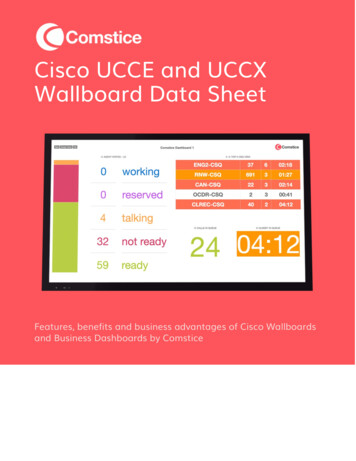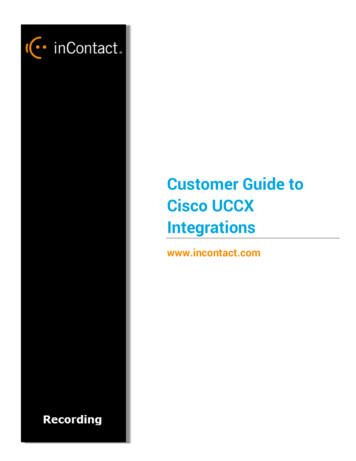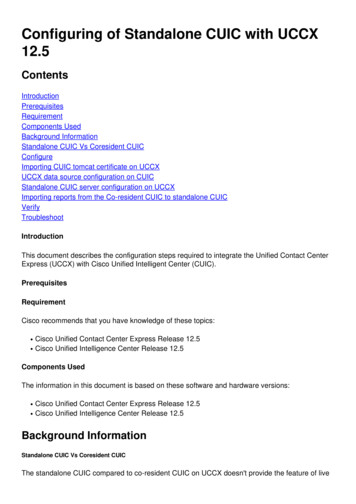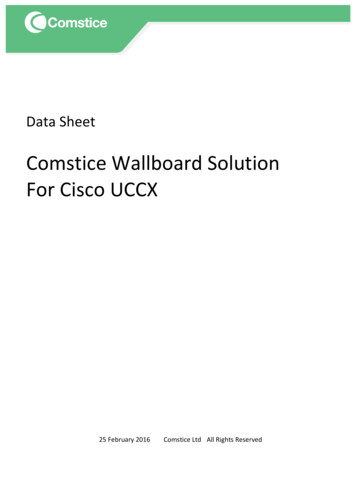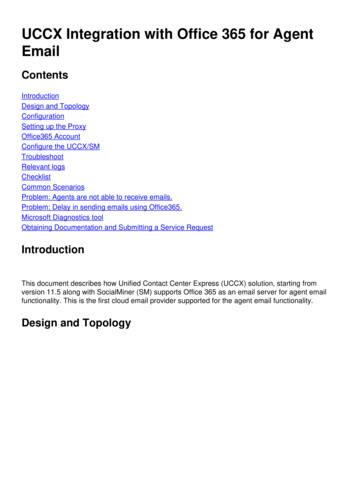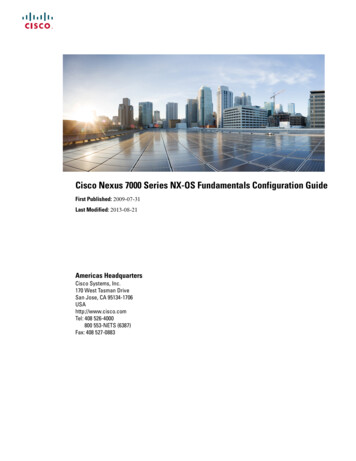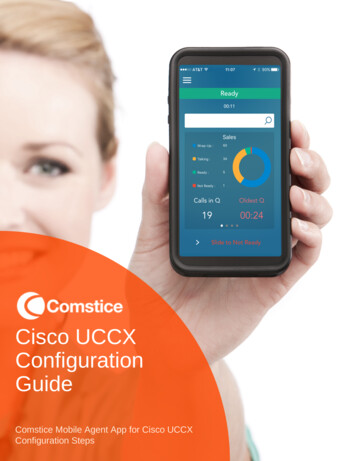
Transcription
Cisco UCCXConfigurationGuideComstice Mobile Agent App for Cisco UCCXConfiguration Stepsmade with
Mobile Agent App BenefitsContact Center Agent without Desktop PCComstice Mobile Agent App is a Cisco Finesse client on IPhone and Android. Ithelps agents that have no access to Desktop PCs to login as an agent andreceive customer calls through their mobile phone.No Additional Server RequiredComstice Mobile Agent App communicates directly with Cisco Finesse server,there is no additional server required.Using Cisco AnyConnect Mobile VPN or anyother mobile VPN client, agent app can communicate with Cisco Finesse directly.Firewall NAT can be used as well to access Cisco FinesseAccess to Customer CRM DataUsing the built-in mobile browser, agent can access to the CRM or ticket details ofthe calling customer and update the customer data. Comstice Mobile Agent Appcan integrate with any web-based CRM platform such as SalesForce, ZenDeskand display customer data.Agent Selection based on GeolocationGeolocations of mobile agent app users can be monitored centrally usingComstice Location Server hosted in your network. Once calling party's geolocationis identified either using speech recognition or a front desk agent, the call can berouted automatically by Cisco UCCE to the nearest agent available.
Comstice Mobile Agent withCisco UCCXCisco UCCX uses Cisco CUCM Extend and Connect feature to help Finesseagents to login without any Cisco phone or softphone. Comstice Mobile Agent appfor Cisco Finesse utilises Extend and Connect feature to deliver customer calls toagent mobile phones.Cisco documentationRequirementsCisco UCCX v10 or higher, Cisco CUCM v9.0 or higherCisco IM and Presence Server v9.0 or higherConfiguring Cisco UCCXCisco UCCX utilises Cisco CUCM Extend and Connect feature to allow agents touse non-Cisco device to receive customer calls. By default, Cisco Extend andConnect feature creates a permanent call to the third party phone as soon asagent logs as Cisco Finesse agent. This is obviously not acceptable in mobilephones, therefore we need to disable "Persistent Connection" feature in CiscoUCCX.Go to Cisco UCCX Admin page System System Parameters PersistentConnection and select "Disable"
Configuring Extend andConnectHere are the main steps for configuring Cisco CUCM and CUPS for ComsticeMobile Agent in Cisco UCCX. The detailed steps can be found here;Cisco documentation1. Please make sure that Cisco IM and Presence Server pre-installation tasks arecomplete.2. Add Cisco IM and Presence Server into Cisco CUCM Cluster;System Server Server Type IM and Presence3. Install Cisco IM and Presence Server as a Cisco CUCM Subscriber4. Activate and start the IM and Presence services in Cisco Unified Serviceability5. Create Presence Redundancy Group in Cisco CUCM;System Presence Redundancy Groups Add New
Configuration - 26. Create UC Services for CTI and IM and Presence in Cisco CUCM;User Management User Settings UC ServiceAdd UC Service for CTI7. Add another UC Service for IM and Presence in Cisco CUCM. Try to use thesame naming convention given above.8. Create a new Service Profile in Cisco CUCM and select CTI and IM&PresenceUC Services you created;User Management User Settings Service Profile
Configuration - 39. Create an end user in Cisco CUCM for the agent or modify the existing enduser for the agent.In the Service Settings section, select Enable User for Unified CM IM andPresence (Configure IM and Presence in the associated UC Service Profile) andthen in UC Service Profile, select the profile that you created.In the Mobile Information section, select Enable Mobility.In Permissions, add Standard CCM End user and Standard CTI enabled.Navigate to User Management Assign Presence End Users. Click the AgentUser ID that you want to set up and then choose Assign Selected Users.10. Make sure that Cisco CUCM trunks and Route patterns are set up to callagent mobile phone numbers in Cisco CUCM.11. Create a Presence Gateway in Cisco IM and Presence Server12. Cisco CUCM simulates the user's device with CTI Remote Device feature.Create a new CTI Remote Device for the agent;Device Phone Add New CTI Remote Device
Configuration - 413. Complete the relevant settings in the Device Level such as CSS etc.14. Add remote destination to the device. Please make sure that any outsideprefixes are included to dial the agent mobile phone number.15. On the remote destination settings, you can name the remote destination asmobileAlso select "Enable Extend and Connect".Go back to the device level in the CTI Remote Device and select;16. Configure Line 1 in CTI Remote Device;- Add an extension and calling permissions
Configuration - 5- Set Maximum Concurrent: 2 Busy Trigger: 1- Associate the Line to the CUCM End User you created for the Finesse agent. (atthe bottom of the page)- Set No Answer Ring Duration to 2517. (Optional) Configure Cisco UCCX Scripts Select Resource Step;Click Connect Yes and set the Ring Time as 20 seconds.This helps to avoid calls to be taken back to the queue by Cisco UCCX if callestablishment gets delayed.18. (Optional) Create a CUCM Application User for accessing Corporate Directory:Comstice Mobile Agent app can access Cisco CUCM Corporate Directory, findand dial contacts. In order to do that, you need to create an application user inCisco CUCM and let Comstice know about its details.Application user also needs to have AXL API Access. You can create a new roleUser Management User Settings Role and add AXL API AccessThen User Management User Settings Access Control Group and assign therole from the top right dropdown "Assign Roles to Access Control Group"This will help Comstice Mobile Agent app to access CUCM Corporate Directoryand Active Directory contacts if they are both integrated.made with
Cisco UCCX utilises Cisco CUCM Extend and Connect feature to allow agents to use non-Cisco device to receive customer calls. By default, Cisco Extend and Connect feature creates a permanent call to the third party phone as soon as agent logs as Cisco Finesse agent. This is obviously not acceptable in mobile
